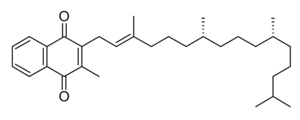Fat Soluble Vitamins
Vitamins are essential nutrients that are required by the body. They all have a unique role in maintaining normal cell function, growth and development. Vitamins are classified into two categories:
- Fat soluble vitamins (A, D, E and K),
- Water soluble vitamins (B and C).
Fat-soluble vitamins, once ingested, the body uses what it needs at the time and stores the rest in fat tissue. The vitamins can be stored and remain here until they are needed for future use. If too much is ingested this can cause hypervitaminosis, a potentially dangerous condition. Deficiencies can also occur when fat intake is low or if fat absorption is compromised in certain conditions (e.g. taking certain drugs, cystic fibrosis).
In contrast water-soluble vitamins are not stored in the body. The body uses the amount needed and any excess is excreted in urine. As they are not stored, the body requires a constant supply in order to stay healthy.
Vitamin A (retinal)
Role
- Good vision: It is a component of retinal pigments, which helps especially in low lighting.
- Reproduction, cell division and gene expression.
- Participates in bone and tooth development.
- Maintains mucous membranes of the mouth , nose, throat and lungs, by keeping them moist.
- Maintains healthy skin.
- Antioxidant, which may protect against cancer. Beta-carotene is an antioxidant.
- Supports immune function.
Source
Vitamin A primarily comes form animal sources: eggs, meat, fortified milk, cheese, cream, liver, kidney, cod, and halibut fish oil. Beta-carotene comes from colourful fruits and vegetables, such as carrots, pumpkin, winter squash, dark green leafy vegetables and apricots. Usually the more intense the colour of the fruit or vegetable, the more beta-carotene it contains.
Excess
This can either be acute or chronic and can present with a number of symptoms. Acute toxicity causes dry, itchy skin, headache, nausea, loss of appetite and blurred vision. Severe toxicity can result in growth retardation, enlargement of the liver and spleen, loss of hair, bone pain, increased pressure in the skull and skin changes. Increased amounts of beta-carotene can turn the skin yellow or orange.
Deficiency
This is usually associated with strict diet restriction or excessive alcohol intake.
- Mild: night blindness, diarrhea, reduced resistance to infection, impaired vision.
- Severe: inflammation of the eyes, keratinisation of the skin and eyes and blindness in children.
Vitamin D
Vitamin D:
Role
Participates in metabolism of calcium and phosphate and maintains adequate serum concentrations of both. It also promotes calcium absorption in the gut. Vitamin D is especially important in growing children, as it is needed for strong bones and teeth. Research shows that it also provides protection against osteoporosis, hypertension, cancer, and some autoimmune diseases.
Source
Primary source is milk and other dairy products. It is also found in oily fish and cod liver oil. It is not only found in foods, it can be synthesised in the skin and is triggered by the exposure to UV rays from sunlight (it is recommended to get 10 to 15 minutes of sunshine three times weekly is enough to produce the body's requirement of vitamin D)
Excess
Toxicity causes elevated plasma concentration of calcium which can have some side effects: Blood vessel contract, high blood pressure and Calcium deposits in soft tissues such as the heart and lungs, Kidney stones, Nausea, vomiting, constipation, poor appetite, weakness, and weight loss.
Deficiency
The main diseases associated with vitamin D deficiency are Osteomalacia and rickets (in children). The symptoms that arise are nausea, weight loss and irritability for mild cases, and mental and physical growth retardation, kidney damage and movement of calcium from bones into soft tissues for the severe cases.
Vitamin E
Role
It is an antioxidant that protects Vitamin A and C, red blood cells and essential fatty acids from becoming destroyed. It also prevents cell membranes from being damaged.
Source
It can be found in natural or synthetic forms. It is found in vegetable oils, cereals, meat, poultry, eggs, fruits, vegetables, legumes, wheat germ oil and whole grain and is also available as a supplement.
Excess
There is an increased risk of bleeding especially in patients taking blood-thinning agents such as heparin, warfarin or aspirin, and in patients with vitamin K deficiency. It can also cause nausea and digestive tract disorders.
Deficiency
This is very rare and impossible to produce without starvation. It generally occurs in infants and people unable to absorb fats.
Vitamin K
Vitamin K is group of compounds derivated from 2-methyl-1,4-naftochinon (IUPAC: 2-methylnaphthalene-1,4-dione).[1]
Role
It has an important role in normal blood clotting (factors II, VII, IX and X are vitamin K dependent, because it works as cofactor in carboxylation of glutamic acid to γ-carboxyglutamic acid which is essential for calcium binding on these factors), for synthesis of protein C and S and it is also needed to help build strong bones.
Role in coagulation therapy
The role of vitamin K is often exploited in anticoagulation treatments in patients with increased risk of thrombosis. These compounds used are referred to as vitamin K antagonists, many of these are coumarin based, the best know of which is warfarin. Coumarin based compounds function by preventing the conversion of the inactive epoxide form of vitamin K into its activated form by inhibiting the enzyme responsible for its reduction ( vitamin K epoxide reductase).
Alternative anticoagulation treatments include heparin (via the inactivation of thrombin) in vivo and EDTA, oxalate and citrate (which remove Ca2+) but can only be used in vitro due to the biological importance of Ca2+.
Source
It is found in green leafy vegetables, such as broccoli and spinach, pulses, vegetable oils, cereals, milk, milk products, meat, eggs and fruit. Bacteria in the intestines can also synthesis Vitamin K and contribute to the available pool.
- requirement: 1 µ/kg/day (except newborns)
Excess
This can cause the breakdown of red blood cells and also liver damage. Therefore if a person is taking blood-thinning agents, they may need to limit the amount of Vitamin K intake.
Note: Vitamin K is an antidote for warfarin.
Deficiency
It is very rare in adults, but can occur in individuals that cannot absorb it properly, due to lack of intestinal bacteria, as well as those being treated long term with antibiotics. It can cause excessive bleeding and increased tendency to bruise. It may also be the cause of haemorrhagic disease of newborn, because placental transfer of vitamin K is very low, its level in breast milk is low as well. (prevention: 1 mg of vit. K intramuscularly 2–6 hours after birth and then 1 mg of vit. K per os every week till age one month, and for exclusively breast feeded children till age 6 months[2]).
Links
Related articles
External links
References
- ↑ WIkiSkripta. Vitami K [online]. ©2011. The last revision 2011-11-29, [cit. 2012-01-26]. <http://www.wikiskripta.eu/index.php/Vitamin_K>.
- ↑ ZEMAN, Jiří. Od příznaků k diagnóze [lecture for subject Paediatrics, specialization General Medicine, 1st Faculty of Medicine Charles University in Prague]. Prague. 2011.
Bibliography
- BENCKO, Vladimir, et al. Hygiene and epidemiology : selected chapters. 2. edition. Prague. 2008. ISBN 80-246-0793-X.







